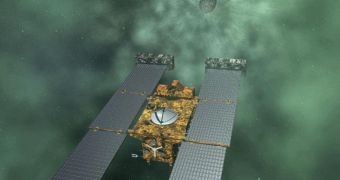Officials at the American space agency announce that the Stardust-NExT mission has finally caught up with its target, comet 9P/Tempel 1. The spacecraft arrived just on time for its planned February 14 flyby, which is scheduled to take place shortly.
The Stardust probe has been tracking down this comet for a few months, after being assigned to this mission years after it completed its original survey. It already flew past two comets in the past, Annefrank (in 2002) and Wild 2 (in 2004).
After that, mission controllers at the NASA Jet Propulsion Laboratory (JPL), in Pasadena, California, put the spacecraft on standby. It remained on hold until about a year ago, when the opportunity arose for it to image Tempel 1.
This sat very well with scientists, because Tempel 1 was visited by the Deep Impact space probe back in 2005. At the time, the spacecraft dropped an impactor on the comet, but it could not analyze the crater on account of the debris field that formed following the impact.
But now, nearly 6 years later, things are bound to be different. The JPL team's biggest hope is for the Stardust probe to be able to image the Deep Impact crater. This could help experts determine the inner structure of the comet, which would be a first-of-its-kind study.
In preparation for this essential flyby, the JPL group uplinked the final course-correction maneuver instructions to the spacecraft on Saturday, February 12. After firing its thrusters accordingly, the probe is now en route for a February 14, 11:37 pm EST (1637 GMT) flyby.
At the point of closest approach, Stardust will come within 200 kilometers of Tempel 1's surface. It will pass by the comet at a speed of about 10 kilometers per second, the JPL team adds.
But scientists are unsure about what they will see when they pass past the comet. Tempel 1 is very unpredictable, in the sense that it generates large plumes of gas and dust particles in large explosions.
If the spacecraft is engulfed in such a plume, then it could get damaged, or it could have its instruments blinded by dust. But the JPL team hopes that this will not happen.
“The primary goal is to find out how much the comet’s surface has changed between two close passages to the Sun since it was last visited in 2005,” explains Cornell University expert Joe Ververka, the principal investigator of the Stardust-NExT mission.
“Temple 1 exhibits a complex rotation. The rotation period is about 41 hours. But the trajectory changes due to the comet jets and activity. Ideally we would like to obtain photos of old and new territory and the crater from the Deep Impact encounter in 2005,” add Tim Larson.
The expert, who is based at the JPL, is the project manager for the Stardust NExT mission, Universe Today reports.

 14 DAY TRIAL //
14 DAY TRIAL //